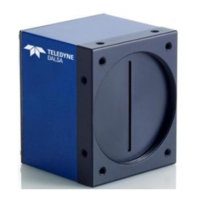52 Spyder3 S3-14 and S3-24 Monochrome Camera User's Manual
03-032-20117-01 Teledyne DALSA
Flat Field Correction Restrictions
It is important to do the FPN correction first. Results of the FPN correction are used in the PRNU
procedure. We recommend that you repeat the correction when a temperature change greater than 10°C
occurs or if you change the analog gain, integration time, or line rate.
PRNU correction requires a clean, white reference. The quality of this reference is important for proper
calibration. White paper is often not sufficient because the grain in the white paper will distort the
correction. White plastic or white ceramic will lead to better balancing.
For best results, ensure that:
50 or 60 Hz ambient light flicker is sufficiently low not to affect camera performance and calibration
results.
For best results, the analog gain should be adjusted for the expected operating conditions and the
ratio of the brightest to darkest pixel in a tap should be less than 3 to 1 where:
The camera is capable of operating under a range of 8 to 1, but will clip values larger than this ratio.
The brightest pixel should be slightly below the target output.
When 6.25% of pixels from a single row within the region of interest are clipped, flat field correction
results may be inaccurate.
Correction results are valid only for the current analog gain and offset values. If you change these
values, it is recommended that you recalculate your coefficients.
Brightest Pixel (per tap)
Note: If your
illumination or white
reference does not
extend the full field of
view of the camera,
the camera will send a
warning.

